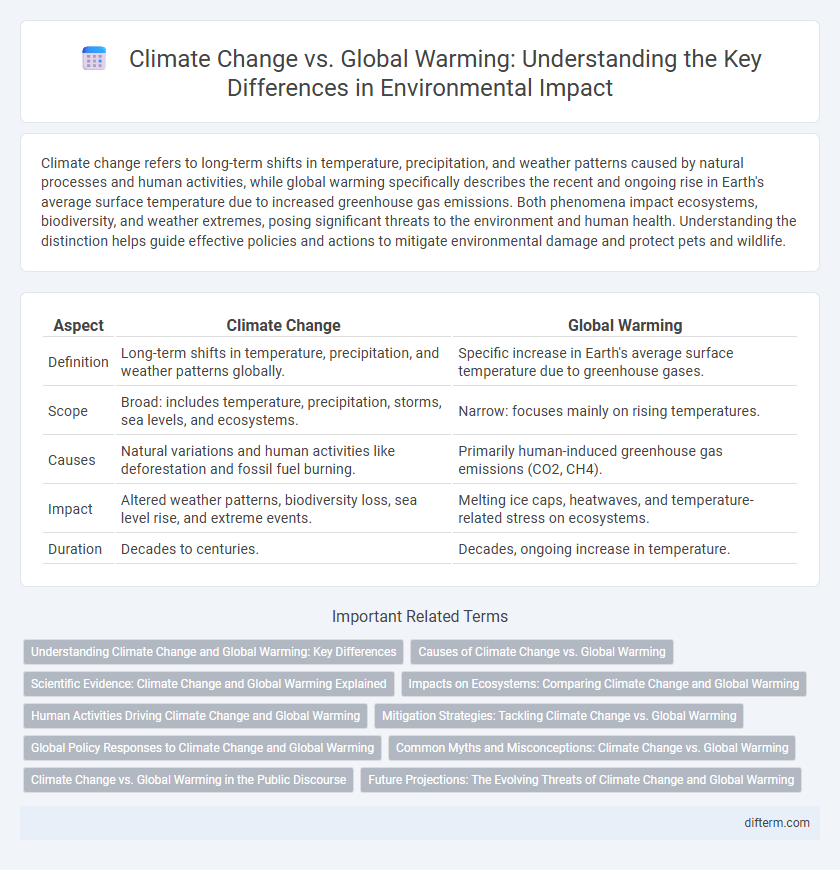Climate change refers to long-term shifts in temperature, precipitation, and weather patterns caused by natural processes and human activities, while global warming specifically describes the recent and ongoing rise in Earth's average surface temperature due to increased greenhouse gas emissions. Both phenomena impact ecosystems, biodiversity, and weather extremes, posing significant threats to the environment and human health. Understanding the distinction helps guide effective policies and actions to mitigate environmental damage and protect pets and wildlife.
Table of Comparison
| Aspect | Climate Change | Global Warming |
|---|---|---|
| Definition | Long-term shifts in temperature, precipitation, and weather patterns globally. | Specific increase in Earth's average surface temperature due to greenhouse gases. |
| Scope | Broad: includes temperature, precipitation, storms, sea levels, and ecosystems. | Narrow: focuses mainly on rising temperatures. |
| Causes | Natural variations and human activities like deforestation and fossil fuel burning. | Primarily human-induced greenhouse gas emissions (CO2, CH4). |
| Impact | Altered weather patterns, biodiversity loss, sea level rise, and extreme events. | Melting ice caps, heatwaves, and temperature-related stress on ecosystems. |
| Duration | Decades to centuries. | Decades, ongoing increase in temperature. |
Understanding Climate Change and Global Warming: Key Differences
Climate change refers to long-term alterations in temperature, precipitation, and weather patterns worldwide, while global warming specifically denotes the rise in Earth's average surface temperature due to greenhouse gas emissions. Climate change encompasses broader impacts including extreme weather events, sea-level rise, and ecosystem disruptions beyond just temperature increase. Understanding these distinctions is crucial for developing targeted environmental policies and effective climate action strategies.
Causes of Climate Change vs. Global Warming
Climate change primarily results from human activities such as deforestation, fossil fuel combustion, and industrial emissions, which increase greenhouse gas concentrations in the atmosphere. Global warming specifically refers to the rise in Earth's average surface temperature caused by these gases, notably carbon dioxide and methane. Both phenomena are interconnected, with global warming acting as a key driver of broader climate change effects including altered weather patterns and sea-level rise.
Scientific Evidence: Climate Change and Global Warming Explained
Scientific evidence demonstrates that global warming refers specifically to the long-term increase in Earth's average surface temperature due to greenhouse gas emissions, while climate change encompasses a broader range of alterations in weather patterns, including temperature, precipitation, and extreme events. Data from NASA and NOAA confirm that global temperatures have risen by approximately 1.2degC since the late 19th century, driven primarily by human activities such as fossil fuel combustion and deforestation. Climate models predict that continued greenhouse gas emissions will intensify global warming effects, leading to more frequent heatwaves, sea level rise, and ecosystem disruptions worldwide.
Impacts on Ecosystems: Comparing Climate Change and Global Warming
Climate change drives shifts in temperature, precipitation, and weather patterns, causing widespread disruptions in ecosystems by altering species distribution and phenology. Global warming, a key component of climate change, specifically refers to rising average surface temperatures, intensifying heat stress, melting glaciers, and contributing to habitat loss for temperature-sensitive species. Both phenomena lead to biodiversity declines, coral bleaching, and altered food webs, but climate change's broader environmental variability causes more complex ecosystem impacts.
Human Activities Driving Climate Change and Global Warming
Human activities such as fossil fuel combustion, deforestation, and industrial processes significantly increase greenhouse gas emissions, primarily carbon dioxide and methane, driving both climate change and global warming. These elevated emissions trap heat in the atmosphere, leading to rising global temperatures, altered weather patterns, and more frequent extreme weather events. The acceleration of these environmental changes is directly linked to human-induced factors rather than natural climate variability.
Mitigation Strategies: Tackling Climate Change vs. Global Warming
Mitigation strategies for tackling climate change prioritize reducing greenhouse gas emissions through renewable energy adoption, energy efficiency, and reforestation efforts, addressing the broader impacts on ecosystems and weather patterns. Global warming mitigation focuses primarily on curbing carbon dioxide and methane emissions to limit average temperature increases, preventing severe heatwaves and sea level rise. Both approaches require international cooperation and sustainable policies to achieve effective long-term environmental stability.
Global Policy Responses to Climate Change and Global Warming
Global policy responses to climate change and global warming emphasize coordinated international efforts such as the Paris Agreement, which aims to limit global temperature rise to well below 2 degrees Celsius by reducing greenhouse gas emissions. Nationally Determined Contributions (NDCs) serve as key mechanisms for countries to outline their specific targets and strategies for mitigation and adaptation. Investments in renewable energy, carbon pricing, and climate finance initiatives also play critical roles in supporting sustainable development and resilience on a global scale.
Common Myths and Misconceptions: Climate Change vs. Global Warming
Climate change and global warming are often used interchangeably, but global warming specifically refers to the Earth's rising surface temperatures caused primarily by greenhouse gas emissions. A common myth is that climate change only means warming, while it also encompasses broader shifts like altered precipitation patterns, extreme weather events, and sea level rise. Misunderstanding these distinctions can hinder effective policy responses and public awareness efforts aimed at mitigating environmental impact.
Climate Change vs. Global Warming in the Public Discourse
Climate change encompasses the broader range of changes affecting global weather patterns, while global warming specifically refers to the rise in Earth's average surface temperature. Public discourse often conflates these terms, leading to confusion about the scope and urgency of environmental issues. Accurate communication distinguishes climate change's complex impacts from the narrower concept of global warming, fostering informed policy and public awareness.
Future Projections: The Evolving Threats of Climate Change and Global Warming
Future projections indicate that climate change will intensify weather extremes, rising sea levels, and biodiversity loss at unprecedented rates by 2100. Global warming, driven by increased greenhouse gas emissions, is expected to push average global temperatures beyond 2degC above pre-industrial levels, exacerbating heatwaves and disrupting ecosystems. Mitigation strategies and adaptive policies are critical to slowing these evolving threats and minimizing long-term environmental and socio-economic impacts.
climate change vs global warming Infographic

 difterm.com
difterm.com